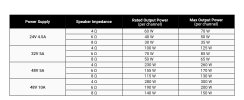Specifically referring to TPA3255-based amps with the typical 32 or 36V/5A brick supply. I see a lot of data in the various review threads -- are the power quotes peak (and I'd multiply by .707 for RMS)?
Looking at the Fosi V3 here:

Converting db to % it seems we're crossing the 1% threshold at 50W (with 32v supply). So perhaps an FTC statement for this amp would be something like: Minimum 35 watts per channel RMS at 8 ohms from 20-20,000Hz, both channels driven, with no more than 1% THD. Far cry from the "300w" number or whatever on the box. What do you guys think?
PS. My fingers are crossed for a 1974-style government smackdown. Get out your poly leisure suit and your flare-bottom corduroys; we're making honest watts great again!
Looking at the Fosi V3 here:
Converting db to % it seems we're crossing the 1% threshold at 50W (with 32v supply). So perhaps an FTC statement for this amp would be something like: Minimum 35 watts per channel RMS at 8 ohms from 20-20,000Hz, both channels driven, with no more than 1% THD. Far cry from the "300w" number or whatever on the box. What do you guys think?
PS. My fingers are crossed for a 1974-style government smackdown. Get out your poly leisure suit and your flare-bottom corduroys; we're making honest watts great again!



 Switched back on, plugged my headphones into the headphone jack which in this model is tapped directly off the output sockets with NO attenuation and left it for a goodly while. of course, the headphone modules fried almost immediately and after the time (twenty minutes?) the case got rather warm but not burning hot. I discovered my mistake, sorted the chip out and the thing is running just fine in my second system to this day ten years or so later. I put it down to the 'modular supply/limiting' design where each gain stage has V/I limiting in case of failure, preventing damage acting akin to knocking down a row of dominoes. Glad the chip wasn't fried as they're like hens teeth today although I believe they can be found here and there - nice old amp that and with kind-of similar 8 ohm power to the Fosi (44WPC at 8 ohms and 64WPC from memory into 4 ohm loads - sounds like it's farting if pushed to clipping I remember) and makes for a totally effortless headphone amp of course - cough...
Switched back on, plugged my headphones into the headphone jack which in this model is tapped directly off the output sockets with NO attenuation and left it for a goodly while. of course, the headphone modules fried almost immediately and after the time (twenty minutes?) the case got rather warm but not burning hot. I discovered my mistake, sorted the chip out and the thing is running just fine in my second system to this day ten years or so later. I put it down to the 'modular supply/limiting' design where each gain stage has V/I limiting in case of failure, preventing damage acting akin to knocking down a row of dominoes. Glad the chip wasn't fried as they're like hens teeth today although I believe they can be found here and there - nice old amp that and with kind-of similar 8 ohm power to the Fosi (44WPC at 8 ohms and 64WPC from memory into 4 ohm loads - sounds like it's farting if pushed to clipping I remember) and makes for a totally effortless headphone amp of course - cough...